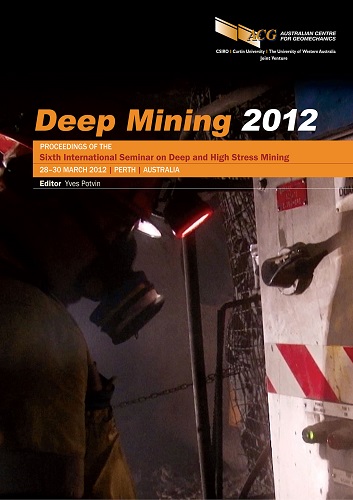Shear slip indication at Big Gossan Mine

|
Authors: Arbi, H; Riyanto, E; Rabbani, R; Meiharrik, L |
DOI https://doi.org/10.36487/ACG_rep/1201_13_arbi
Cite As:
Arbi, H, Riyanto, E, Rabbani, R & Meiharrik, L 2012, 'Shear slip indication at Big Gossan Mine', in Y Potvin (ed.), Deep Mining 2012: Proceedings of the Sixth International Seminar on Deep and High Stress Mining, Australian Centre for Geomechanics, Perth, pp. 189-200, https://doi.org/10.36487/ACG_rep/1201_13_arbi
Abstract:
Big Gossan Mine is a relatively new mining operation that will produce 7,000 tons of ore per day within the greater PT Freeport Indonesia mining operations complex in the province of Papua in Indonesia. Traditionally all mining operations in the underground situation of PT Freeport have been successful block cave entities. The Big Gossan is planned as a paste filled open stope operation and is now in the initial stages of production. As this particular orebody is sited in very close proximity to the milling and concentrating plants, it is imperative to keep the virtually sheer cliffs adjacent to these infrastructures as stable as possible. It was decided that this different mining method would be the optimum in accomplishing this strategic need. Big Gossan is a steep dipping orebody which is located between 300 m and 1,000 m from the surface (hence the cliffs). Initial geological investigations have defined two shear zones that almost parallel the orebody in its southern footwall. These shear zones will be in close proximity and/or intersect all the main service accesses to the production stopes. The stability of these structures and their influence on the integrity of the whole mining operation is a concern in the light of the strategic need to limit any unnecessary deformation within this area of the operations. In the early stage of exploitation, mining induced stresses have caused rock wall damage to the access excavations and continual audible failure is heard by the operational workers. To this end, instrumentation is being installed and utilised to measure deformation and changes in the field stresses. In addition, a local microseismic system has been put in place to measure any seismic activity related to the effects of mining underground in the presence of weak geological structures. Emphasis is also on surface stability and this is underlined by the fact that accelerometers have been installed for this specific purpose. At the onset, the microseismic system recorded no seismic events related to rock failure of any significance. Initial stage events recorded were only related to blasting activity. However, the microseismic system has subsequently started to record seismic events both on surface and underground. After review of some of these seismic event and investigations underground, it was observed that some of these events could be relates to slip movement along the shear zone. Visual inspection of certain areas has yielded information that there is in fact damage propagation related to seismicity, especially in the area where the shear zone intersects the footwall strike drifts. The intention of this paper is to review the steps that have been taken to quantify possible future displacements in the shear zone and to evaluate these in terms of their impact on future mining. In addition, this paper attempts to establish the possible progressive geotechnical hazard with regard to stress build re-distribution in the shear zones as mining progresses with time. This paper is addressed to develop action plan that should be done in geotechnical risk assessment of Big Gossan Mine to identify and minimise these effects upon the operation.
References:
Freeport-McMoRan Copper and Gold Inc. (2005) Feasibility study for Big Gossan Mine, executive summary and report, Vol. I.
Hanks, T. and Kanamori, H. (1979) A moment magnitude scale, Journal of Geophysical Research, Vol. 84, pp. 2348–2350.
Mining Measurement Services Pty Ltd (2010) PT Freeport Indonesia Big Gossan Rock Stress Measurements, Victoria, Australia.
Ryder, J.A. (1988) Excess shear stress in the assessment of geologically hazardous situations, Journal of the South African Institute of Mining and Metallurgy, Vol. 88, No. 1, pp. 27–39.
Ryder, J.A. and Jager, A.J. (2002) A textbook on rock mechanic for tabular hard rock mines, SIMRAC, Johannesburg, South Africa.
SiM Mining Consultants (Pty) Ltd (2009) Training manual, Specific outcomes for mine seismology, Potchefstroom, South Africa.
Smith, M. (2011) Production Stoping Sequence June 2011, Big Gossan engineering report.
Wiles, T.D., Lachenicht, R. and van Aswegan, G. (2000) Integration of deterministic modelling with seismic monitoring for the assessment of the rockmass response to mining: Part I Theory, in Proceedings Sixth International Symposium on Rockburst and Seismicity in Mines (RaSiM6), Y. Potvin and M. Hudyma (eds), 9–11 March 2005, Perth, Australia, Australian Centre for Geomechanics, Perth, pp. 379–387.
© Copyright 2025, Australian Centre for Geomechanics (ACG), The University of Western Australia. All rights reserved.
View copyright/legal information
Please direct any queries or error reports to repository-acg@uwa.edu.au
View copyright/legal information
Please direct any queries or error reports to repository-acg@uwa.edu.au